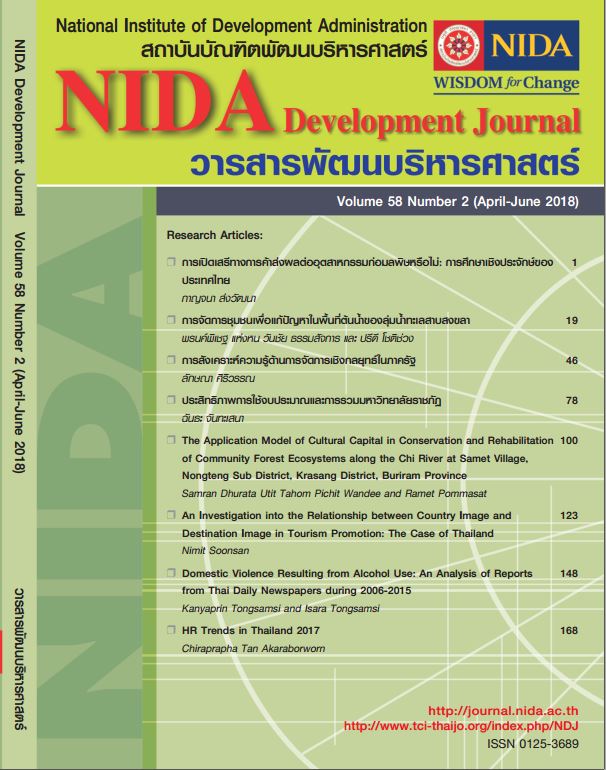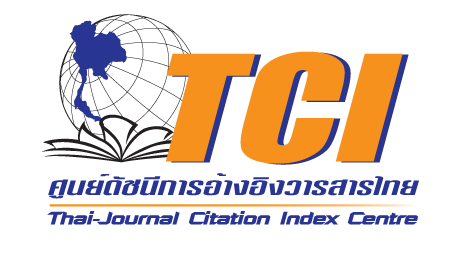HR Trends in Thailand 2017
Keywords:
Human Resources, Trends, Thailand, Workforce Planning, Organization DevelopmentAbstract
This study was conducted in 2016 with four main objectives: (1) to review HR trends from 2015-2017 in a global context, (2) to review future contexts in Thailand that might impact HR practices, (3) to examine HR trends in Thai leading industrials, and (4) to provide HR practitioners with recommendations for preparing for future changes and to suggest future research needs to academics in HR. A survey was distributed online and via e-mails to HR practitioners in 15 industrials with 546 responses. Nine HR functions identified by SHRM (2008) were covered: workforce planning, recruitment and selection, employee relations, compensation and benefits, performance management, training and development, career planning and development, organization development, and CSR (corporate social responsibility). The data were analyzed within each industry and then summarized across industries. The top three increasing trends were performance management, employee relations, and organization development. Under future contexts in Thailand (considering the government policy, Thailand 4.0; the Gig economy; the aging society; and artificial intelligence technology) innovative organization development and workforce planning surfaced as major roles. How to prepare and develop the workforce to support this OD approach needs more discussion among HR practitioners and researchers.
References
Akaraborworn, C. T. (2013). HR trends in Thailand 2012-2013, HROD Journal, 5(1), 40-29. (in Thai)
Akaraborworn, C. T. (2014). HR trends in ASEAN 2014-2015, HROD Journal, 6(1), 4-41. (in Thai)
Almeida, R. K. & deFaria, M. L. (2014). The wage returns to on-the-job training: Evidence from matched employer-employee data. Bonn: The Institute for the Study of Labor (IZA).
AMCHAM (The American Chamber of Commerce in Thailand). (2016). AMCHAM Thailand recognizes top CSR programs. Retrieved on December 20, 2016, from The American Chamber of Commerce in Thailand Web site http://amchamthailand.com/ACCT/asp?news
AonHewitt. (2014). 2014 Trends in global employee engagement. Retrieved on January 20, 2017, from Aon Hewitt Web site http://aonhewitt.com
AonHewitt. (2016). Thailand compensation and benefit trends 2016: Voluntary turnover rates soar as performance pressure mounts. Retrieved on November 16, 2016, from Market wired of NASDAQ Web site http://marketwired.com
Bartlett, K. R. (2005). Survey research in organizations. Paper in Research in Organizations: Foundations and methods of inquiry, Swanson, R. A. & Holton III, E F. (Eds.). San Francisco. Berrett-Koehler Publishers, Inc.
Bersin, J., Agarwal, D., Pelster, B. and Schwartz, J. (Eds.). (2015). Global human capital trends 2015: Leading in the new worked of work. New York: Deloitte University Press
Buckingham, M. & Goodall, A. (April, 2015). Reinventing performance management. Harvard Business Review, 93(4). Retrieved on January, 30, 2017, from Harvard Business Review Web site http://hbr.org/2015/04/reinventing-performance-management.
Canon, H. (2017). 2017 Trends for hiring managers and recruiters. Retrieved on January 19, 2017, from Human Resources Today Web site http://humanresourcestoday.com
CIPD (Chartered Institute of Personnel and Development). (2017). HR Outlook: Views of our profession winter 2016-2017. London: CIPD Publishing.
Cummings, T. G. & Worley, C. G. (2005). Organization development and change. Australia: South-Western College Publishing.
Deloitte. (2016). Global human capital trends 2016: The new organization: Different by design. New York: Deloitte University Press.
Floyd, D. (2016). Gig economy created all net new jobs since 2005. Retrieved on June 2, 2016, from Investopedia Web site.
Friedman, G. (2014). Workers without employers: shadow corporations and the rise of the gig economy. Review of Keynesian Economics, 2(2), 171-188.
Investopedia. (2016). Gig Economy. Retrieved on December 20, 2017, from Investopedia Web site http://investopeida.com/terms/g/gig-economy.asp
Korn Ferry Hay Group. (2016). Salary forecast: Wages expected to rise globally, with biggest pay increase in three years. Media & Press.
Lagunas, K. (2012). High potentials vs. high performers: A manager’s guide to identify, assess and develop. Retrieved on October 26, 2012, from The New Talent Times http://new-talent-times.softwareadvice.com/high-potentials-vs-high-performers-a-managers-guide-to-identify-assess-and-develop-1081012/
Lauby, S. (2016). Employment branding is dead. Retrieved on June 26, 2016 from Human Resources Today Web site http://humanresourcestoday.com
Linstone, H. A. and Turoff, M. (1975). The delphi method: Techniques and applications. Reading, Mass.: Adison-Wesley.
Ministry of Labor. (2016). Ministry of labor prepares workforce for Thailand 4.0. Retrieved on December 23, 2016, from Ministry of Labor Web site http://mol.go.th/content.
OECD/UNESCO. (2016). Education in Thailand: An OECD/UNESCO perspective, reviews of national policies for education. Paris: OECD Publishing.
Onozawa, N. (2013). A study of CSR in Thailand (I): Awareness and practice. Retrieved on December 20, 2016 from United Nations Global Compact Web site http://www.unglobalcompact.org/aboutthege/thetenprinciples/index.html.
PricewaterhouseCoopers. (2014). Rethinking your performance management program. South San Francisco: SuccessFactors, Inc.
Randstad. (2016). HR Trends and salary report. Retrieved on May, 20, 2016, from Randstad Web site https://www.randstad.gr/editor/uploads/files/Surveys/Salary%20Survey_2016_eng_LR.pdf
Ratanajongkol, S. Davey, H. & Low, M. (2006). Corporate social reporting in Thailand: The news is all good and increasing, Qualitative Research in Accounting & Management, 3(1). 67-83.
Rau, B. L. & Adams, G. A. (2012). Aging, retirement, and human resource management: A strategic approach. In M. Wang (Ed.) The Oxford Handbook of Retirement. Oxford: Oxford University Press.
Robert Walters. (2015). Strong career development to retain top talent in Thailand. Retrieved on February 5, 2015, from Market wired of NASDAQ Web site http://marketwired.com/press-release/strong-career-development-to-retain-top-talent-in-thailand-1988945.thm
Rovinelli, R. J. & Hambleton, R. K. (1977). On the use of content specialists in the assessment of criterion-referenced test item validity. Dutch Journal of Educational Research, 2, 49-60.
Russel, S. J. Norvig, P. (2003). Artificial intelligence: A modern approach (2nd ed.), Upper Saddle River, New Jersey: Prentice Hall.
Schawbel, D. (2014). 2015 Workplace Trends. Retrieved on October 10, 2014, from Forbes Web site http://forbes.com/sites/danschawbel/2014/10/29/the-top-10workplace-trends-for-2015
Schawbel, D. (2016). 2017 Workplace trends you’ll see in 2017. Retrieved on November 1, 2016, from Forbes Web site http://forbes.com/sites/danschawbel/2016/11/01/workplace-trends-for-2017
Seabrook, A. (2016). The trick to recruiting talent that sticks with social media. Retrieved on July 7, 2016, from Human Resources Today Web site http://humanresourcestoday.com
SHRM (Society of Human Resource Management). (2008). SHRM Workplace Forecast. Retrieved on December 3, 2008, from Society for Human Resource Management http://shrm.org/research
SHRM (Society of Human Resource Management). (2008). Staffing Research: The employer brand: A Strategic Tool to attract, recruit and retain talent. VA: SHRM Research Department.
SHRM (Society of Human Resource Management). (2016). Future insights: Top trends affecting the workplace and the HR professional according to SHRM special expertise panels. VA: SHRM Research Department.
Soponkij, U. (2010). The ODI impact of leadership styles, shared values, and skills in relation to employee satisfaction and employee engagement: A case study of mid-size company in Thailand. AU-GSB eJournal, 3(1), 46-55.
Sritanyarat, D. (2008). HR Trends in Thailand in 2009-2010. Unpublished master’s independent study. School of Human Resource Development, The National Institute of Development Administration, Thailand. Bangkok: The National Institute of Development Administration (in Thai)
The Government Public Relations Department. (2016). National development in accordance with the Thailand 4.0 Policy. Retrieved on December 20, 2016, from The Government of Public Relations Department Web site http://thailand.prd.go.th
TIR (Thailand Investment Review). (2017). Thailand 4.0 means opportunity Thailand. Retrieved on January 30, 2017, from The Board of Investment of Thailand Web site http://boi.go.th
The World Bank. (June, 2016). Thailand economic monitor – June 2016: Aging Society and Economy. Retrieved on December 22, 2016, from The World Bank Web site http://worldbank.org/en/country/Thailand
Towers Watson. (2016). 2016 Compensation surveys – Thailand: Data, analytics, insights and experience from a market leader. Printed by Towers Watson Data Service.
Virakul, B., Koonmee, K. & McLean, G. N. (2009). CSR activities in award-winning Thai companies. Social Responsibility Journal, 5(2), 178-199.
WillisTowersWatson. (2016). Willis Towers Watson Thailand Foresees 5.5% Average Salary Increase in 2017. Retrieved on January 20, 2016, from Willis Towers Watson Web site https://http://willistowerswatson.com/en/press/2016/11/Willis-Towers-Watson-Thailand-foresees-5-point-5-percent-average-salary-increase-in-2017
Yudkowsky, E. (2008). Artificial Intelligence as a positive and negative factors in global risk. In Global Catastrophic Risks, edited by Nick Bostrom and Milan M. Cirkovic, 308-345. New York: Oxford University.





